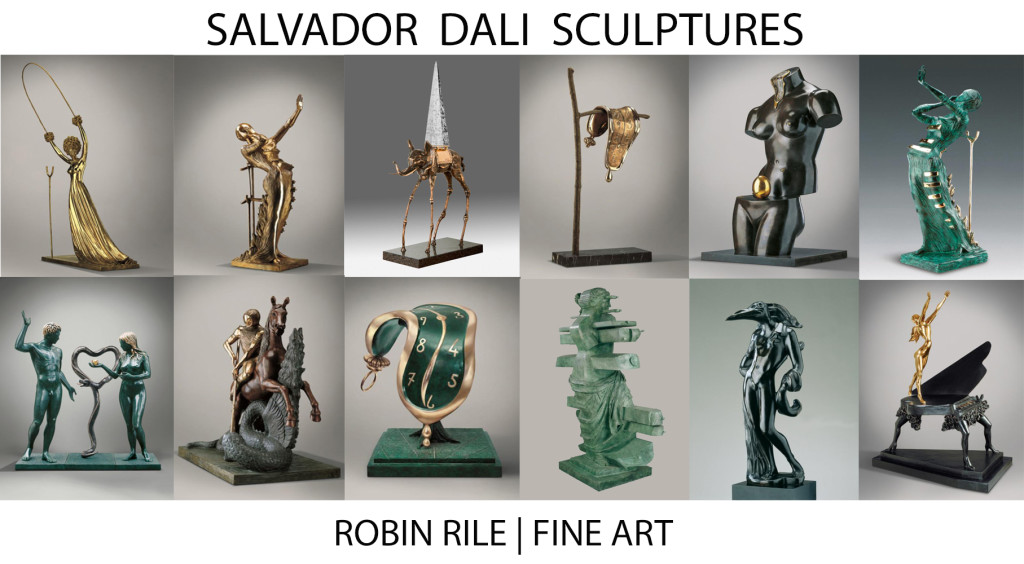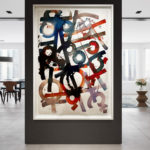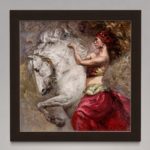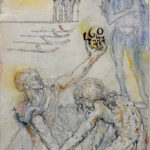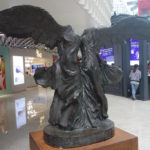 Of all the movements in Modern Art (including Impressionism, Cubism & Dadaism) the Surrealist Movement was, in many respects, the most important and influential of the modern era. It was spearheaded by poets such as Andre Breton, whose “The Surrealist Manifesto” (1924) became the benchmark from which many other artists were inspired. One of the most respected & prolific artists of the Surrealist movement of the 20th century was Spanish-born master Salvador Dali (1904-1989). Embracing Surrealism and bringing it to the forefront of public awareness, Dali explored both the conscious and subconscious mind to coalesce reality, dreams, science and religion into tangible form. Recognized as much for his theatrics as his art, Dali’s unique style criss-crossed the many mediums in which he worked: Drawing, etching, poetry, painting, film, set & furniture design, costume, jewelry & product design and sculpture.
Of all the movements in Modern Art (including Impressionism, Cubism & Dadaism) the Surrealist Movement was, in many respects, the most important and influential of the modern era. It was spearheaded by poets such as Andre Breton, whose “The Surrealist Manifesto” (1924) became the benchmark from which many other artists were inspired. One of the most respected & prolific artists of the Surrealist movement of the 20th century was Spanish-born master Salvador Dali (1904-1989). Embracing Surrealism and bringing it to the forefront of public awareness, Dali explored both the conscious and subconscious mind to coalesce reality, dreams, science and religion into tangible form. Recognized as much for his theatrics as his art, Dali’s unique style criss-crossed the many mediums in which he worked: Drawing, etching, poetry, painting, film, set & furniture design, costume, jewelry & product design and sculpture.
In the 1930’s and inspired by the Dadaists, Dali began creating 3-dimensional assemblages with found objects including shoes, glasses of milk, bread, telephones and lobsters. “One day,” the artist told Playboy magazine, “I exhibited a mannequin with a very long bread on its head; There were a lot of ants on her face. But Picasso, that destroyer of beauty, also destroyed IT . His dog jumped on it and ate the bread.” In addition to odd combinations of existing objects, Dali recreated classical works with a surreal twist. In 1964, Dali and his friend Marcel Duchamp endeavored to update one of history’s most recognized sculptures: Venus de Milo. Cast bronze, but painted white to resemble plaster, the armless sculpture contained 6 drawers, a Freudian reference to the places that women store away their secrets. Dali continued to revisit the classics throughout his career, oftentimes paying homage to the great thinkers and artists who came before him, including Spanish court painter Diego Velazquez. In an unusual twist on a classic sculpture, Salvador Dali created “Otorhinological Head of Venus de Milo“, featuring a bust of a woman in which the ear and nose are transposed, leaving the viewer both aghast and humored by the reinterpretation. Ever experimenting, Salvador Dali later mastered the art of glass by creating sculptures with DAUM Glassworks of Nancy, France. The artist used the tar-like glass paste to morph objects into three dimensional objects, oftentimes using found materials washed up on the beach, as inspiration.
Sculpting was an art form Dali wholeheartedly embraced, often sitting in the warm Spanish sun with a glass of his favored Moscato, creating wax modeles which would later be cast into bronze sculptures in the lost wax method. Dali’s swimming pool in Port Lligat became the creative catalyst for the artist to create more than 40 stream-of-conscious sculptures which encapsulate his haptic, coarse nature. Collectively, the works became known as the “Clot Collection, named for his publisher Isidro Clot. Amorphic in their shape, the artist pushed and pulled bands of white wax which softened in the Catalan sun.
The lost wax or “cire perdue” method of casting sculpture dates back as far as 5000 B.C. The technique allows the artist’s impermanent wax figures to be translated into a more stable and permanent material; Bronze. The artist was involved in the creative processes which served as the basis for a bronze edition, while the technical processes of casting and patination were left to skilled artisans who specialize in casting. Some molds for sculptures were created directly by the hand of Dali in the form of wax or plaster, while others were developed from themes found in his paintings and drawings. The themes in the latter category often echo Dali’s most recognizable imagery, including melting clocks, angels, long-legged elephants, Alice in Wonderland and Women Aflame. Sculpting allowed Dali’s paintings to become tangible, tactile and three dimensional.
In the comprehensive catalogue raisonne of Dali’s bronzes, “The Hard and the Soft, Sculptures & Objects“, the late Dali expert Robert Descharnes and his son Nicolas, explore all of the sculptural output the artist created during his career, from the earliest experiments to the finished bronzes of his later career. The elder Descharnes met Dali on a transatlantic liner in 1950 on their way back from New York, and began a friendship which would last forty years. Descharnes became Dali’s biographer and official photographer, documenting details of his work and his life over the course of decades. Thousands of photographs were taken of Dali, his wife Gala, their eccentric lifestyle and their travels. In turn, Descharnes became one of the leading experts on the artist until his death in 2014. His son, Nicolas, is considered one of the foremost experts on Dali, holding access to the comprehensive archives and consulted regularly by collectors, museums and auction houses. His approval of a work from Dali is now considered the Gold-Standard by which the artist’s work can be measured.
2019 marks the 30th anniversary of Dali’s passing.
FOR INFORMATION ON AVAILABLE SCULPTURES FOR PURCHASE, contact info@robinrile.com
The Sculpture of Salvador Dali copyright Robin Rile Fine Art

